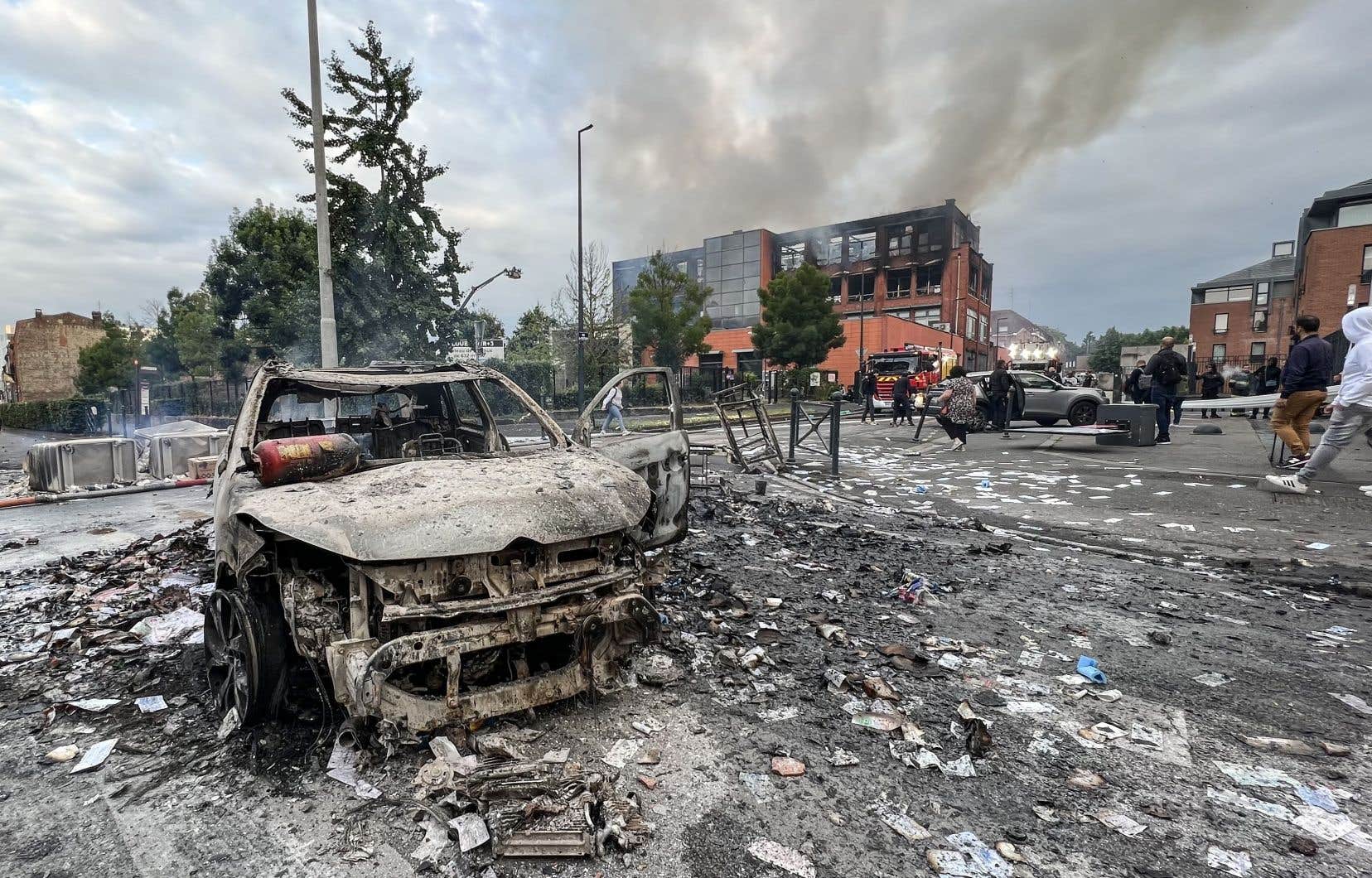Scenes of looting, burned vehicles, degraded public buildings: the French government is trying to stem the violence on Friday after a third night of riots and vandalism, including with the deployment of armored vehicles from the gendarmerie.
Many French cities, in the Paris region and in the provinces, bear the scars of this third night of violence on Friday, often the work of adolescents.
Faced with this violence, triggered by the death of Nahel M., 17, killed by a police officer on Tuesday in Nanterre, in the Paris region, the government decided to resort to drastic measures, without however establishing the state of emergency demanded by part of the political world.
The funeral of this young man must take place on Saturday, announced the mayor of Nanterre.
At the end of an interministerial crisis meeting, the second in two days, Prime Minister Elisabeth Borne announced the deployment of armored gendarmerie vehicles and the cancellation of “large-scale events” throughout the country, in order to to release police personnel.
Buses and trams, often targeted by protests of violence, will also be at a standstill across the country from 9 p.m. local time, the government said.
President Emmanuel Macron, who cut short his stay in Brussels on Friday morning, had already announced a reinforcement of the means for the police after this crisis meeting. He also called for parental responsibility as the youth of the perpetrators of violence struck the spirits.
“A third of those arrested last night are young people, sometimes very young people,” he observed on Friday, accusing social networks of fueling this violence.
“Spirit of Responsibility”
A meeting between the government and the digital platforms is scheduled for Friday at 6:30 p.m. local time, in order to “alert” the latter “about their responsibility” in the urban violence which is shaking France, announced the services of Mme Thick headed.
Mr. Macron said he expected a “spirit of responsibility” from these platforms, citing in particular Snapchat and TikTok, where “violent rallies” are organized and which “also arouse a form of mimicry of violence, which leads to the most young people to a form of exit from reality”, according to him.
Nahel’s death after refusing to comply at the wheel has revived the subject of police violence, in a country where 13 people died following a police check last year, even beyond French borders.
During the regular UN press briefing in Geneva on Friday, the United Nations High Commissioner for Human Rights urged France “to seriously address the deep-seated problems of racism and racial discrimination among the forces of the order”. An accusation deemed “totally unfounded” by the French Ministry of Foreign Affairs which immediately.
Several public gatherings, parties or others, will be canceled in the departments most affected by the violence, which also worries the neighbors of France.
Berlin “worried”
Berlin expressed its “concern” at the situation, and recalled that the French authorities had “clearly condemned” Nahel’s death.
The United Kingdom warned its citizens on Friday against these riots, which caused scenes of desolation in several large or medium-sized cities.
“It’s the first time in 25 years that I’ve seen this,” says Yvan – who didn’t want to give his last name –, a cleaner in a shoe store in the center of Paris.
Crumbled windows, stolen shoes… Both the shop and the store of a famous American sports brand a few meters away were looted and ransacked in the middle of the night.
As of Friday morning, Mr.me Borne brought together several ministers, denouncing “unbearable and inexcusable” acts.
“All hypotheses” are considered to restore “republican order”, including the state of emergency, said Friday Mme Borne, before this meeting, which did not however accept this hypothesis, at least for the moment.
Mr. Macron said he was ready for his part to adapt “without taboos” the device for maintaining order.
Electrocuted
The state of emergency, which allows the administrative authorities to take exceptional measures such as a traffic ban, was triggered in November 2005 after 10 days of riots in the suburbs, triggered by the death of two teenagers, electrocuted in an electrical transformer where they had hidden to escape the police.
The new violence also broke out after the death on Tuesday of a teenager, shot in the chest during a traffic check by a police officer. The latter, a 38-year-old motorcyclist, was charged Thursday with intentional homicide and placed in detention. A video shows him holding the young man at gunpoint before shooting at point-blank range when the car suddenly restarts.
The unrest has gone crescendo since Tuesday and spread to new cities overnight from Thursday to Friday, during which 492 buildings were affected, 2,000 vehicles burned and 3,880 public road fires started, according to official figures. 875 people, often very young, were arrested.
“Schools, municipal police, annex town halls, social centers, buses, trams have been targeted, attacked, vandalized, ransacked”, denounced the president of the Paris region Valérie Pécresse by denouncing acts “intolerable vis-à-vis the “public services that the inhabitants need”.
In the poorest department of metropolitan France, Seine-Saint-Denis, north-east of Paris, “almost all the municipalities” have been affected, often by flash actions, with many public buildings targeted, according to a police source. In Drancy, rioters used a truck to force the entrance to a shopping center, partly looted and burned, said a police source.
In Paris itself, around forty businesses were degraded according to the Public Prosecutor’s Office. Stores in the city center “were vandalized”, “looted or even burned”, according to a high-ranking police officer.
An Apple store in the center of Strasbourg (east) was also vandalized in broad daylight on Friday.
At least three cities near the capital decided on Thursday to introduce curfews.
The government had however announced the mobilization Thursday evening of 40,000 police and gendarmes, including 5,000 in Paris (against 2,000 the previous night).
